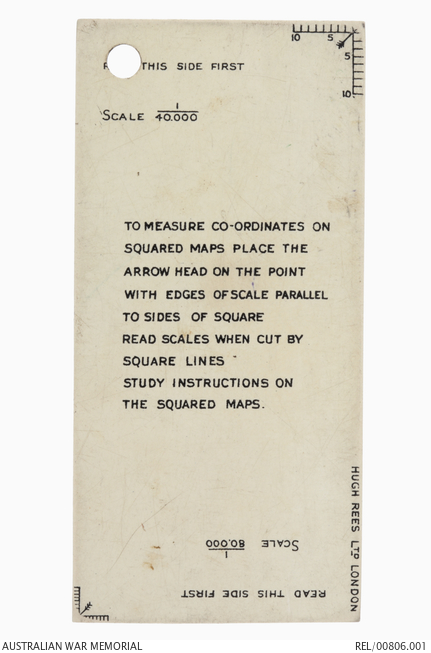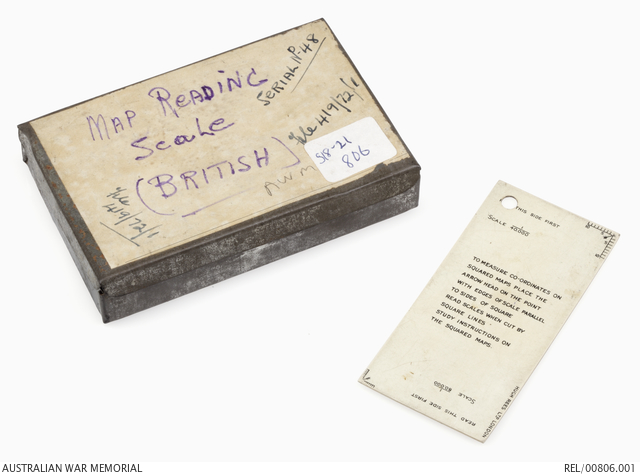| Place | Europe: Western Front |
|---|---|
| Accession Number | REL/00806.001 |
| Collection type | Heraldry |
| Object type | Heraldry |
| Physical description | Celluloid |
| Maker |
Hugh Rees Ltd |
| Place made | United Kingdom: England, Greater London, London |
| Date made | c 1914-1918 |
| Conflict |
First World War, 1914-1918 |
Map Reading Scale : Lieutenant General J Monash, AIF



Double sided map reading scale. On one side is a grid on a corner at the scale of 1;10,000 with an arrow pointing into the corner. On the opposite corner is a grid to the scale of 1:20,000 with an arrow pointing into the corner. The other side has a grid on a corner at the scale of 1:40,000 and on the opposite corner to the scale of 1:80,000 both with with an arrow pointing into the corner. The maker's details are also printed on this side.
Both sides are is printed 'READ THIS SIDE FIRST' along the shorter edges, and in the centre 'TO MEASURE CO-ORDINATES ON / SQUARED MAPS PLACE THE / ARROW HEAD ON THE POINT / WITH EDGES OF SCALE PARALLEL / TO SIDES OF SQUARE / READ SCALES WHEN CUT BY / SQUARE LINES / STUDY INSTRUCTIONS ON / THE SQUARED MAPS.' A hole has been punched through one corner of the map reading scale.
John Monash was born in Melbourne on 27 June 1865. He was dux of Scotch College and studied arts and engineering at Melbourne University, where he was also involved in debating and student politics. Outside of university he dabbled in acting. In 1884 he joined the university company of the 4th Battalion, Victorian Rifles.
Monash worked on the construction of the Princes Bridge in Melbourne and in 1888 was placed in charge of constructing a new railway even though he had yet to complete his degree. He married Hannah Moss in April 1891. He finished his studies in 1895 and, having decided to combine engineering with a military career, was promoted to captain in the Garrison Artillery that year. In 1897 Monash was promoted to major in the North Melbourne Battery and served there for 11 years.
Meanwhile, he and a friend had established a private engineering practice in 1894. The business grew steadily but a series of setbacks left him with large debts in 1902. Starting again, Monash recovered and became wealthy. He also gained promotion to lieutenant colonel in the Australian Intelligence Corps in 1908. Now prospering in business and in the Army, in 1913 Colonel Monash took command of the 13th Infantry Brigade.
After the outbreak of war, Monash was appointed to command of the AIF's 4th Infantry Brigade, landing at Gallipoli on 26 April 1915. In July he was promoted to brigadier. Monash took his brigade to France in June 1916. He was promoted to major general in July and took command of the 3rd Division. The division's first major battle, Messines, was hailed as a great success. Further successes followed and in May 1918, Monash was promoted to lieutenant general and given command of the Australian Corps. His first battle in this role, Hamel, came to be considered the 'perfect battle'. Monash remained in command through the victorious battles in the last months of the war.
After spending eight months in London overseeing the repatriation of the AIF, Monash was welcomed home in Melbourne by an enthusiastic public on Boxing Day 1919. He returned to business and in 1920 became manager of Victoria's State Electricity Commission. An advocate for returned soldiers, Monash also held a range of high-level positions. His opinions were widely sought and he became a leading figure in Melbourne's Jewish community.
Monash was promoted to general in November 1929. He died of heart disease in Melbourne on 8 October 1931 and was given a state funeral attended by some 250,000 mourners.